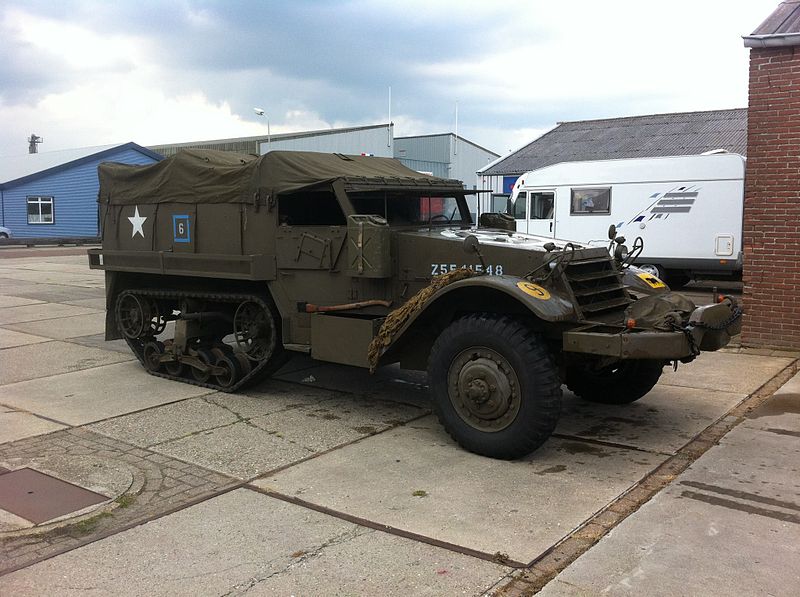Hello ladies and gents this is the viking telling you that today we are talking about

M5 HALF TRACK

The M5 half-track (officially the Carrier, Personnel, Half-track, M5) was an American armored personnel carrier in use during World War II. It was developed in 1942 when existing manufacturers of the M2 half-track car, and M3 half-track could not keep up with production demand. International Harvester (IH) had capacity to produce a similar vehicle to the M3, but some differences from the M3 had to be accepted due to different production equipment. IH produced the M5 from December 1942 to October 1943.
Using the same chassis as their M5, IH could produce an equivalent to the M2, which was the M9 half-track. There were also variants of the M13 and M16 MGMCs based on the M5. The M13 and M16 were exported to the United Kingdom and to Soviet Union respectively. The M5 was supplied to Allied nations (the British Commonwealth, France, and the Soviet Union) under the Lend-Lease. After WWII, the M5 was leased to many NATO countries. The Israel Defense Forces used it in several wars and developed it into the M3 Mark A and the M3 Mark B.
The specifications of the M5 were almost identical to the specifications of the M3 half-track. It was 20.8 feet (6.3 m) long, 7.3 feet (2.23 m) wide, 9 feet (2.74 m) high, and weighed 21,500 pounds (9.8 t). It had vertical volute springs for the tracks and semi-elliptical longitudal leaf springs for the wheels. It was powered by a 142 hp (106 kW) White 160AX, 386 cubic inch (6,330 cc), 6-cylinder engine, with a compression ratio of 6.35:1. It had a fuel capacity of 60 US gallons (230 l), a range of 125 miles (201 km), and a speed of 42 miles per hour (68 km/h). It had constant mesh transmission, 6.5–13.5 mm (0.26–0.53 in) of armor, one 0.5 in (12.7 mm) M2 machine gun and two 0.3 in (7.6 mm) M1919 machine guns, and crew of three with up to ten passengers. The track was a endless rubber-band track which was made of molded rubber over steel cabling with metal track guides
VARIANTS
M3E2/M5 – An IH half-track, that was virtually identical to the M3. The only differences was the thicker armor (up to 20 mm), different engine (IHC RED-450-B), and lower range (125 mi (201 km)). This model was mainly supplied to the Soviet Union, the British Commonwealth, and France. A total 4,625 were produced.
M5A1 – M5 with a M49 machine gun mount. It could fit one 0.5 inch (12.7 mm) M2 Browning heavy machine gun, and two 0.3 inch M1919 Browning machine guns, and 2,859 were produced.
M5A2 – Similar to the M3A2, the M5A2 was a combination of the M5 and M9 half-tracks. This was a project that was never mass produced.
M9 – Same as the M5, stowage arranged as the M2 half-track car, with access to radios from inside (as opposed to outside) and rear doors, plus pedestal machine gun mount, with 2,026 being produced.
M9A1 – Same as the M9, with ring mount and three machine gun pintles, with 1,407 being produced.
M14 half-track – A version of the M13 Multiple Gun Motor Carriage, based on the M5. It had two 0.5 in machine guns mounted in a M33 Maxson turret on the rear of the chassis. Several hundred were produced before it was replaced by the M16 MGMC and M17 MGMC, with a total 1,605 were produced.
M17 half-track – M5 with the same quadruple 0.5 inch machine gun turret as the M16 MGMC. All 1,000 were supplied to the USSR. It saw limited use at end of World War II and was also deployed during the Korean War.
M3 Mk. A – A modified M5. The only difference was the variety of machine guns were used in place of the M49 mount.
M3 Mk. B – A M5 modified as a command carrier. It had extra radios and a front winch bumper
I hoped you liked this post and as always have a chilled day from the viking.
Comments
Post a Comment